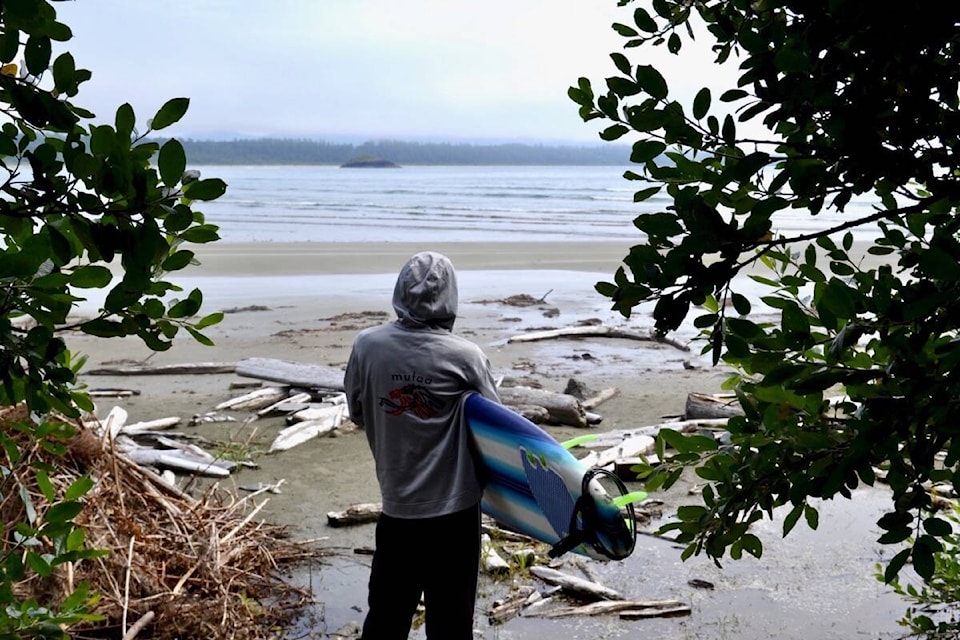It’s Friday afternoon at Long Beach in the Pacific Rim National Park Reserve. Surfers wait on the shore as the thick August fog burns off and the tide inches up.
Looking north of Lovekin Rock towards the Tla-o-qui-aht First Nation (TFN) community of Esowista, a group of brown faces clad in wetsuits play freely like seals in the lineup, bodysurfing friendly summer waves and taking turns paddling a lone green soft top surfboard.
This is Canada’s Indigenous surf team. This is Mułaa.
“I want to catch really big waves and get barrelled,” 11-year-old Halidzox Rampanen beams after completing the two week summer surf and water safety training from Aug. 2 to 12. She says all the surfing and the ocean safety has made her feel smarter.
“In foggy conditions, don’t go too far out,” Rampanen shares.
Pronounced Mu-th-laa, the word means rising tide in TFN language. Mułaa was founded in 2019 by Rachel Dickens and Alyssa Fleishman as a vessel to get more Nuu-chah-nulth youth in the ocean. In a couple short years, the Tofino surf and business community have stepped up with over $20,000 in donations, plus a surf shed was constructed this summer outside the TFN education building to house surfboards and wetsuits.
Dickens says now that they have a place to store all the equipment, they are looking to acquire new gear or like-new surfboard donations. Navigating the line between getting new gear versus quality used gear is tricky, as mom Nitanis Desjarlais states. On the one hand, kids grow so fast, but on the other, it’s really great to have new equipment, especially a new surfboard without dings and holes.
“The equipment is really expensive and so is the wetsuit. It’s kind of a privileged sport because if you have the means, you can buy the wetsuit,” said Desjarlais, noting that she has three kids on the Mułaa surf team. “I was looking for a used surfboard and even then saw it was a bit pricey. Somebody saw my kids loved surfing and gifted them a longboard that they now share.”
Mułaa surf team is open to all Nuu-chah-nulth youth 10 and over, but they also welcome all Indigenous people that are young at heart. Dickens says regular Monday meet-ups at Esowista will start-up again in the fall.
“That’s what I love about Rising Tide is that the opportunity is there if they wanted to. My kids didn’t know they loved surfing because they didn’t have the equipment and now they do. Just having a place and a space and opportunity I think you are going to see more brown bodies in their own ocean where they belong,” said Desjarlais.
Ivan Wells Jr., 21, is from Ehattesaht, a Nuu-chah-nulth First Nation near Zeballos. He has a family house on Esowista and joined the two-week Mułaa surf and water safety camp.
“I had a lot of fun. These past couple weeks have definitely rekindled my enjoyment for all kinds of boarding sports. I know there are a lot of kids in the water, but making more programs available and more boards going around would make surfing more accessible,” said Wells Jr.
There are stories from the late Hesquiaht First Nation Simon Lucas about a form of surfing taking place in ancient Nuu-chah-nulth times, according to Desjarlais.
“They used to have little cedar canoes shaped like surfboards and they would have little competitions. (Lucas) said as a boy, that’s what they used to do.”
Anyone interested in learning more about Mułaa is encouraged to visit their website www.risingtidesurf.com or check out their Instagram @risingtidesurf.
RELATED: New tax for Tofino surf schools strengthens call for lifeguards
nora.omalley@westerlynews.ca
Like us on Facebook and follow us on Twitter.
READ MORE: Canada wins historic Junior surf medal at an international competition
READ MORE: History made at 15th edition of the Rip Curl Pro Nationals in Tofino
